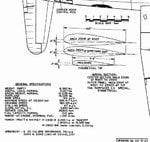Navigation
Install the app
How to install the app on iOS
Follow along with the video below to see how to install our site as a web app on your home screen.
Note: This feature may not be available in some browsers.
More options
You are using an out of date browser. It may not display this or other websites correctly.
You should upgrade or use an alternative browser.
You should upgrade or use an alternative browser.
Washout/wing twist F4U
- Thread starter mad_max
- Start date
Ad: This forum contains affiliate links to products on Amazon and eBay. More information in Terms and rules
More options
Who Replied?- Thread starter
- #3
drgondog
Major
Tomo - not sure that is the 'final answer'. Recall that the wing root incidence spanwise has a termination point at the Gull Wing interaction with outer wing..I would believe that the spanwise distribution from there to tip is Zero to -2 degrees. It is hard to believe no washout given the requirement for roll authority at low speed for carrier landing.Seems like there was no washout, the 'America's hundred thousand' says that wing incindence was 2 deg both at root and tip.
Edit: picture
Tomo - not sure that is the 'final answer'. Recall that the wing root incidence spanwise has a termination point at the Gull Wing interaction with outer wing..I would believe that the spanwise distribution from there to tip is Zero to -2 degrees. It is hard to believe no washout given the requirement for roll authority at low speed for carrier landing.
We know that F4U have had a problem with low-speed handling, in particual with a tendency to 'drop a wing' - IIRC a 'whole' wing on one side will drop in the same instant, vs. eg. Spitfire that will produce enough of stall warning due to having a washout (meaning that root will start to stall, but the ooutboard-ish section of a said wing will still produce lift).
FWIW, I've cropped te part of the picture linked from above, it depicts 2 deg incindence at root, at the 'kink' and at theoretical tip:

Last edited:
MIflyer
1st Lieutenant
The F4U was unusual in that it was a big, fast, powerful, heavy airplane with fabric covered outer wings and wooden fabric covered ailerons. Also, washout at the tip is required less if you use differential ailerons. The Ercoupe has no washout at the outer tip but has a stall strip at the root and highly differential ailerons; spin resistance was a primary objective.
drgondog
Major
Interesting and informative. The two advantages I can think of are 1.) no incremental induced drag introduced with twist/washout, and b.) simpler jig/tooling for constant incidence.We know that F4U have had a problem with low-speed handling, in particual with a tendency to 'drop a wing' - IIRC a 'whole' wing on one side will drop in the same instant, vs. eg. Spitfire that will produce enough of stall warning due to having a washout (meaning that root will start to stall, but the ooutboard-ish section of a said wing will still produce lift).
FWIW, I've cropped te part of the picture linked from above, it depicts 2 deg incindence at root, at the 'kink' and at theoretical tip:
View attachment 491041
Vought introduced a spoiler on one lower wing (right?) to initiate 'common' stall speed at high angle of attack due to upwash/downwash created by prop vortex.
If the idea of washout is for the inner wing to stall before the outer wing does, wouldn't the bend in the wing achieve that? Although the wing profile and angle of incidence may be uniform there is obviously a bigger surface area underneath the wing than above it?
Users who are viewing this thread
Total: 1 (members: 0, guests: 1)
Similar threads
- Replies
- 64
- Views
- 7K
